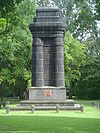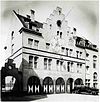Rudolf Schultze (architect)
Rudolf Carl Julius Schultze (born April 30, 1854 in Berlin ; † June 20, 1935 in Bonn ) was a German architect and master builder of Bonn.
Live and act
Schultze was the eldest son of the post director Julius Schultze († 1895) and grew up in his native Berlin. In October 1875 he began studying architecture at the Berlin Bauakademie (from 1879 Technical University Berlin ). His formative teachers there included Johann Eduard Jacobsthal and Johann Heinrich Strack , an architect from the Schinkel School . On September 16, 1879, he passed the first state examination, which was followed by several years of employment as a government building manager at the post office building administration in Berlin and Erfurt . After passing the second state examination in March 1884, Schultze was appointed government master builder for structural engineering , after which he worked for the structural engineering department of the Berlin magistrate .
In 1888, Schultze was employed by the city of Cologne as a city planning inspector. In this role he was responsible for the city's water supply together with Carlsteueragel . In 1895 the municipal building commission in Bonn selected him from among 60 applicants for the vacant position of the master builder at the intercession of the mayor Wilhelm Spiritus - who had met Schultze as a municipal councilor in Cologne. According to the decision of the city council on December 13, 1895 to appoint Schultze, he took up his new position on February 1, 1896 under the title of "city building officer". He was then responsible for the municipal building management, which gained in importance during his tenure and grew in terms of the number of employees from 32 to 83 people. Her main tasks after Schultze took office included the construction of Bonn's first Rhine bridge (1896-98), the expansion of the road network including the regulation and paving of the sidewalks and the road embankments and the connection of all houses to the previously extremely patchy and haphazard canal network up to the incorporation some suburbs in 1904. During Schultze's tenure, the city first issued or created development and alignment plans and a canal plan.
As a city architect, Schultze also made his own architectural designs . His most important works in this function include the expansion of the slaughterhouse in Weststadt (around 1895), the Kaiser Wilhelm Memorial on the Venusberg (1897) on the occasion of the 100th birthday of Wilhelm I , the town hall in Gronau (1901 ), the eye clinic built for the university on Wilhelmstraße (1903), the municipal vehicle fleet on Ellerstraße (1903), the Viktoriabad as Bonn's first indoor swimming pool (1906) and the first vocational school building planned as such in Prussia on what was then Bornheimer Straße (1913) .
Memberships and public offices
Schultze was also involved in Bonn as a local politician. On 8 November 1901 he was appointed Assistant Secretary selected the city and determined as such on October 4, 1904. first Deputy Mayor. Schultze was a member of the Association of Friends of Antiquity in the Rhineland and its long-time vice-president until his retirement for reasons of age in July 1933.
Research work
Schultze has carried out archaeological research in the civil engineering work he is in charge of and has been responsible for since he started working as a town construction inspector in Cologne and published some of the results of his finds in specialist journals, including the Bonn yearbooks . In the course of the expansion of the sewer system in Cologne, he and his colleague Carl Steueragel researched the topography of the Roman city on the basis of structural evidence and, after many years of observations, used this to present plans and descriptions of Roman roads in the area of the oppidum period port basin in 1895 , which were considerable until 1930 have been expanded. Since the construction sites of the city had not been regularly observed with regard to the historical finds, Schultze can be regarded as a co-founder of the Cologne antiquity research as a systematic branch of research.
Family and private
Schultze was married to Johanna, born Grosse (1857–1931). The marriage resulted in a child, Fritz Schultze (1890-1918), who served in the First World War as first lieutenant of the foot artillery regiment No. 9 and fell in this mission in Buzancy near Soissons . Rudolf Schultze rests in the Poppelsdorf cemetery .
plant
![]() Map with all coordinates: OSM | WikiMap
Map with all coordinates: OSM | WikiMap
Buildings in Bonn
| construction time | District | address | image | object | measure | Remarks |
|---|---|---|---|---|---|---|
| around 1895 | West town | Immenburgstrasse |  |
slaughterhouse | extension | Monument protection |
| 1897 | Venusberg | Rosenburgweg / At the Casselsruhe location |
 more pictures |
Kaiser Wilhelm Monument | New building (execution: Johannes Degen; client: City of Bonn) | Monument protection |
| 1897 | Bonn center | Doetschstrasse |  |
Municipal high school | New building | Destroyed in the war in 1944 |
| 1900 | Gronau | Heimkehrerweg location |
 more pictures |
Bismarck Tower | New building: construction management (design: Wilhelm Kreis ) | Monument protection |
| 1901 | Gronau | location |
 more pictures |
City Hall | New building | Destroyed in the war in 1944 |
| 1901-1903 | Bonn-Castell | Graurheindorfer Straße 80 location |
 more pictures |
Elementary school ("north school") | New building | today GHS "Am Römerkastell"; Monument protection |
| 1902 | North city | Ellerstrasse 48 location |
 |
Municipal vehicle fleet ("Ellerhof") | New building | today office and residential use; Monument protection |
| 1903 | Bonn center | Wilhelmstrasse |  |
Eye clinic | New building (client: University of Bonn) | Destroyed in the war in 1944 |
| 1905 | North city | Maxstrasse |  |
Fire station | New building | Canceled in 1973 |
| 1906 | Bonn center | Franziskanerstrasse |  |
Viktoriabad | New building (sculptor: Karl Menser ) | first indoor swimming pool in Bonn; War damaged in 1944, canceled in 1969 |
| 1909 | North city | Dorotheenstrasse 126 location |
 |
Karlschule | New building | Monument protection |
| 1913 | Bonn center | Budapester Strasse 23 location |
 more pictures |
Compulsory advanced training school | New building | first vocational school building in Prussia; until 2013 Pestalozzi School; Monument protection |
| 1913-1915 | Südstadt | Loestrasse 14 location |
more pictures |
Municipal Lyceum | New building | today Clara-Schumann-Gymnasium ; Monument protection |
Awards
- 1907: Red Eagle Order IV class
- 1917: Secret building councilor
- 1919: Honorary doctorate from the Rheinische Friedrich-Wilhelms-Universität Bonn (awarded by the Philosophical Faculty)
- 1929: Entry in the Golden Book of the City of Bonn
Fonts (selection)
- (together with Carl Steuerungagel ): Colonia Agrippinensis. A contribution to the local knowledge of the city of Cologne in Roman times. (= Yearbooks of the Association of Friends of Antiquity in the Rhineland , issue 98.) Bonn 1895. (with 17 plates).
- The Roman city gates , Carl Georgi, 1910.
- The historical planning of the city of Bonn from 1815–1915 , Bonn 1919. [unpublished].
Web links
- Josef Niesen : Rudolf Carl Julius Schultze , Rheinische Geschichte portal, April 17, 2014
References and comments
- ↑ a b c d e f g h i j k l m n o p q r s t u v w Josef Niesen: Rudolf Carl Julius Schultze , Portal Rheinische Geschichte, April 17, 2014.
- ↑ a b c d Rudolf Peil: Vocational School in the Mirror of Time ( Memento from December 30, 2014 in the Internet Archive ) (PDF)
- ^ Helmut Heyer: Culture in Bonn in the Third Reich (= City Archives and Scientific City Library: Publications of the City Archives Bonn. ISSN 0524-0352 , Volume 62), City Archives and City History Library, Bonn 2002, ISBN 3-922832-32-6 , p. 191.
- ↑ Klaus Goettert: To town architecture in Cologne. Triltsch, Düsseldorf 1960, p. 5. (also dissertation University of Cologne, 1960).
- ^ Walter Geis, Ulrich Krings (ed.): Cologne, the Gothic town hall and its historical surroundings (= city traces, monuments in Cologne. Volume), JP Bachem, Cologne 1998, ISBN 3-7616-1391-1 , p. 96.
- ^ Hugo Borger, Helga Schmidt-Glassner: The Roman-Germanic Museum Cologne. Callwey, Munich 1977, ISBN 3-7667-0384-6 .
- ↑ Hermann Mylius: The north gate of the Colonia Agrippinensis. In: Kölner Jahrbuch für Pre- und Frühgeschichte , Gebr. Mann, Berlin 1955, p. 9 ff.
- ^ Alfred Schäfer: The great Cologne thermal baths: excavation and monument protection ( Memento from December 30, 2014 in the Internet Archive ). In: Deutscher Archäologen-Verband eV: Announcements from the German Archaeologists Association, Volume 40/2009, Issue 2, pp. 74–85 (here: p. 76).
- ↑ in the case of buildings that no longer exist - if known - the last valid address
- ↑ Detailed description in: Josef Niesen, Bonner Monuments and their Builders, Königswinter 2013.
- ^ Gabriele Zabel-Zottmann: Sculptures and objects in the public space of the federal capital Bonn: Installed from 1970 to 1991 . Dissertation, Bonn 2012. Part 2, p. 13 ( online ; PDF; 5.8 MB).
- ^ Andreas Denk , Ingeborg Flagge : Architekturführer Bonn . Dietrich Reimer Verlag, Berlin 1997, ISBN 3-496-01150-5 , p. 67.
- ↑ until 1977/78 Bornheimer Straße 9 ( entry in the Bonn street cadastre)
| personal data | |
|---|---|
| SURNAME | Schultze, Rudolf |
| ALTERNATIVE NAMES | Schultze, Rudolf Carl Julius (full name) |
| BRIEF DESCRIPTION | German architect and master builder of Bonn |
| DATE OF BIRTH | April 30, 1854 |
| PLACE OF BIRTH | Berlin |
| DATE OF DEATH | June 20, 1935 |
| Place of death | Bonn |